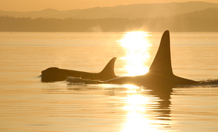
Post reproductive mother and son. Photo by David Ellifrit, Centre for Whale Research.
Long menopause allows killer whales to care for adult sons
Scientists have found the answer to why female killer whales have the longest menopause of any non-human species - to care for their adult sons.
Led by the Universities of Exeter and York and published in the journal Science the research shows that, for a male over 30, the death of his mother means an almost 14-fold-increase in the likelihood of his death within the following year.
The reason for the menopause remains one of nature’s great mysteries and very few species have a prolonged period of their lifespan when they no longer reproduce, as in humans. However, female killer whales stop reproducing in their 30s-40s, but can survive into their 90s. While different theories have been put forward for the evolution of menopause in humans, including the well-established ‘grandmother’ hypothesis, there has been no definitive answer to why females of a small number of other species, including killer whales, also stop reproducing part-way through their lives.
The research team, from the Universities of Exeter and York (UK), the Center for Whale Research (USA) and Pacific Biological Station (Canada) analysed records spanning 36 years, of the members of two populations of killer whales (Orcinus orca) in the North Pacific ocean, off the coast of the USA and Canada.
They found that the presence of a female who was no longer reproducing significantly increased her older offspring’s survival. In the case of males over the age of 30, a mother’s death meant a 14-fold increase in the likelihood of their death within a year. Females also stay within their mother’s group but for daughters of the same age, the difference is just under three-fold. For females under the age of 30, the death of their mothers had no effect on their survival rates.
Killer whales live in unusual social groups, with sons and daughters staying with their mothers in a single group throughout their lives. With this close association, older mothers have the opportunity to increase the transmission of their genes by helping their adult offspring survive and reproduce. When sons mate, their offspring are cared for by females in another group, whereas when daughters reproduce the offspring stay in the group, which increases local competition for resources within the group.
Theory predicts that in order to have the best chance of spreading their genes, without carrying an additional burden, mothers should focus their efforts on their sons. This research backs up this theory and demonstrates the extent to which older sons are dependent on their mothers for survival.
Lead author on the paper, University of Exeter PhD student Emma Foster said: “Killer whales are extraordinary animals and their social groups are really unusual in that mothers and their sons are lifelong companions. Our research suggests that they have developed the longest menopause of any non-human species so that they can offer this level of commitment to their older offspring.”
Dr Dan Franks, from the Department of Biology at the University of York, said: "Our analysis shows that male killer whales are pretty much mommy's boys and struggle to survive without their mother's help. The need for mothers to care for their sons into adulthood explains why killer whales have evolved the longest post-reproductive lifespan of any non-human animal."
Dr Darren Croft of the University of Exeter's added: “Both humans and killer whales are unusual in having a long menopause. Although they share this trait, the way older females benefit from ceasing reproduction differs, reflecting the different structure of human and killer whale societies. While it is believed that the menopause evolved in humans partly to allow women to focus on providing support for their grandchildren, it seems that female killer whales act as lifelong carers for their own offspring, particularly their adult sons. It is just incredible that these sons stick by their mothers’ sides their entire lives.”
This research was supported by the Biotechnology and Biological Sciences Research Council (BBSRC), the Leverhulme Trust and Earthwatch.
Date: 13 September 2012
